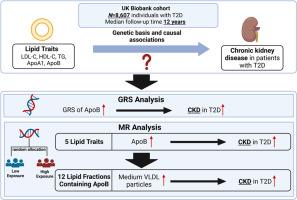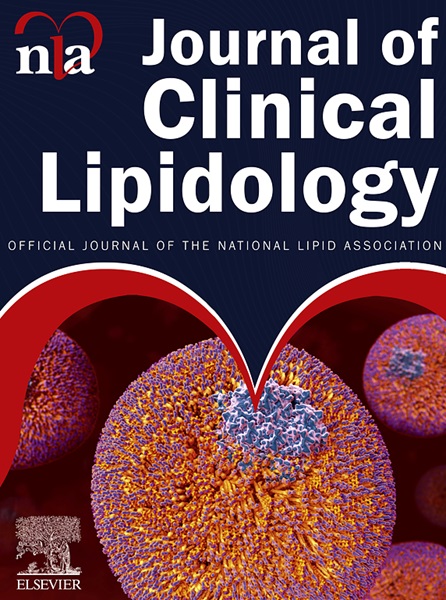遗传关联分析凸显脂蛋白 B 是 2 型糖尿病患者慢性肾病的决定因素之一
IF 3.6
3区 医学
Q2 PHARMACOLOGY & PHARMACY
引用次数: 0
摘要
背景2型糖尿病(T2D)患者的血脂水平与慢性肾脏病(CKD)有关,但其遗传基础和因果关系仍不清楚。方法我们的前瞻性分析涉及英国生物库中基线时患有T2D但无CKD的8607名白人参与者。五种常见的血脂特征被列为暴露因子。针对这些血脂特征制定了加权遗传风险评分(GRS)。采用线性或非线性孟德尔随机化(MR)方法探讨了血脂特征以及血脂组分与慢性肾脏病之间的因果关系。结果调整潜在混杂因素后,载脂蛋白 B(ApoB)的 GRS 越高,CKD 风险越高(危险比 (HR) [95% 置信区间 (CI)]:每 SD 1.07[1.02,1.13]; P = 0.008)。线性MR表明,遗传预测的载脂蛋白B水平与CKD之间存在正相关(HR [95% CI]:1.53 [1.12,2.09];P = 0.008),但没有发现其他血脂特征与T2D患者的CKD之间存在关联的证据。关于 12 种含有载脂蛋白 B 的脂质组分,发现中极度低密度脂蛋白颗粒与 CKD 之间存在显著的因果关系(HR[95% CI]:1.16[1.02,1.32];P = 0.020)。非线性 MR 不支持这些因果关系中的非线性。结论较低的载脂蛋白B水平与T2D患者的CKD风险降低存在因果关系,因此载脂蛋白B是该人群预防CKD的潜在治疗目标。本文章由计算机程序翻译,如有差异,请以英文原文为准。

Genetic association analyses highlight apolipoprotein B as a determinant of chronic kidney disease in patients with type 2 diabetes
BACKGROUND
Blood lipid levels were associated with chronic kidney disease (CKD) in patients with type 2 diabetes (T2D), but the genetic basis and causal nature remain unclear.
OBJECTIVE
This study aimed to investigate the relationships of lipids and their fractions with CKD in patients with T2D.
METHODS
Our prospective analysis involved 8,607 White participants with T2D but no CKD at baseline from the UK Biobank. Five common lipid traits were included as exposures. Weighted genetic risk scores (GRSs) for these lipid traits were developed. The causal associations between lipid traits, as well as lipid fractions, and CKD were explored using linear or nonlinear Mendelian randomization (MR). The 10-year predicted probabilities of CKD were evaluated via integrating MR and Cox models.
RESULTS
Higher GRS of apolipoprotein B (ApoB) was associated with an increased CKD risk (hazard ratio (HR) [95% confidence interval (CI)]:1.07[1.02,1.13] per SD; P = 0.008) after adjusting for potential confounders. Linear MR indicated a positive association between genetically predicted ApoB levels and CKD (HR [95% CI]:1.53 [1.12,2.09]; P = 0.008), but no evidence of associations was found between other lipid traits and CKD in T2D. Regarding 12 ApoB- containing lipid fractions, a significant causal association was found between medium very-low-density lipoprotein particles and CKD (HR[95% CI]:1.16[1.02,1.32];P = 0.020). Nonlinear MR did not support nonlinearity in these causal associations. The 10-year probability curve showed that ApoB level was positively associated with the risk of CKD in patients with T2D.
CONCLUSION
Lower ApoB levels were causally associated with a reduced risk of CKD in patients with T2D, positioning ApoB as a potential therapeutic target for CKD prevention in this population.
求助全文
通过发布文献求助,成功后即可免费获取论文全文。
去求助
来源期刊
CiteScore
7.00
自引率
6.80%
发文量
209
审稿时长
49 days
期刊介绍:
Because the scope of clinical lipidology is broad, the topics addressed by the Journal are equally diverse. Typical articles explore lipidology as it is practiced in the treatment setting, recent developments in pharmacological research, reports of treatment and trials, case studies, the impact of lifestyle modification, and similar academic material of interest to the practitioner.
Sections of Journal of clinical lipidology will address pioneering studies and the clinicians who conduct them, case studies, ethical standards and conduct, professional guidance such as ATP and NCEP, editorial commentary, letters from readers, National Lipid Association (NLA) news and upcoming event information, as well as abstracts from the NLA annual scientific sessions and the scientific forums held by its chapters, when appropriate.

 求助内容:
求助内容: 应助结果提醒方式:
应助结果提醒方式:


